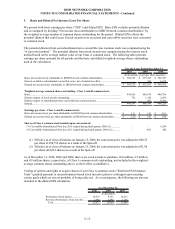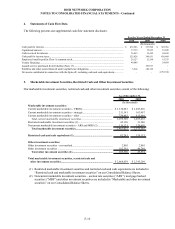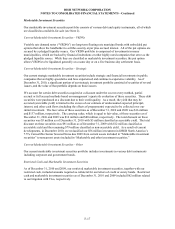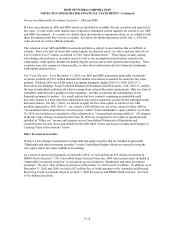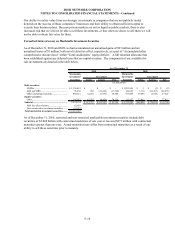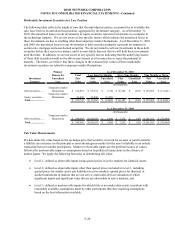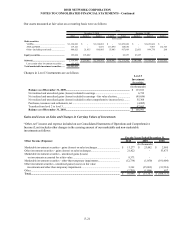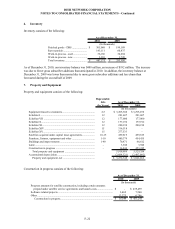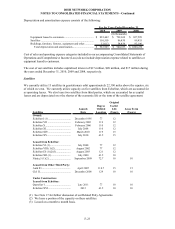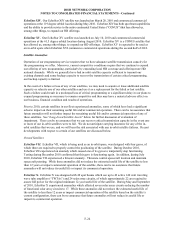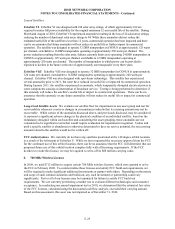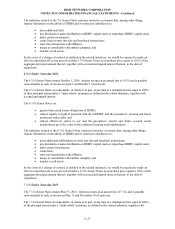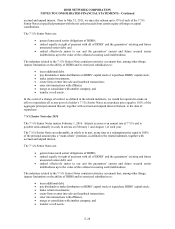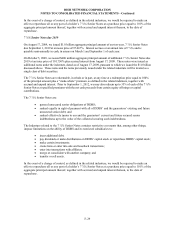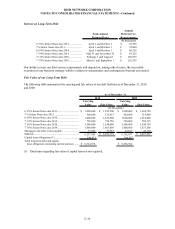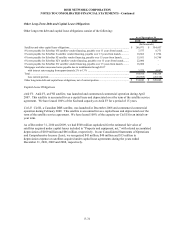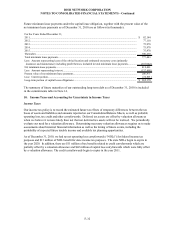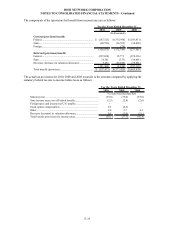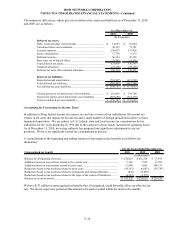Dish Network 2010 Annual Report Download - page 110
Download and view the complete annual report
Please find page 110 of the 2010 Dish Network annual report below. You can navigate through the pages in the report by either clicking on the pages listed below, or by using the keyword search tool below to find specific information within the annual report.DISH NETWORK CORPORATION
NOTES TO CONSOLIDATED FINANCIAL STATEMENTS - Continued
F-25
Leased Satellites
EchoStar VI. EchoStar VI was designed with 108 solar array strings, of which approximately 102 are
required to assure full power availability for the original minimum 12-year useful life of the satellite. During
March and August of 2010, EchoStar VI experienced anomalies resulting in the loss of 24 solar array strings,
reducing the number of functional solar array strings to 84. While these anomalies did not reduce the
estimated useful life of the satellite to less than 12 years, commercial operation has been impacted and there
can be no assurance that future anomalies will not reduce its useful life or further impact its commercial
operation. The satellite was designed to operate 32 DBS transponders in CONUS at approximately 125 watts
per channel, switchable to 16 DBS transponders operating at approximately 250 watts per channel. The
power reduction resulting from the solar array failures currently limits us to operating 24 DBS transponders in
CONUS at approximately 125 watts per channel, switchable to 12 DBS transponders operating at
approximately 250 watts per channel. The number of transponders to which power can be provided is
expected to decline in the future at the rate of approximately one transponder every three years.
EchoStar VIII. EchoStar VIII was designed to operate 32 DBS transponders in CONUS at approximately
120 watts per channel, switchable to 16 DBS transponders operating at approximately 240 watts per
channel. EchoStar VIII was also designed with spot-beam technology. This satellite has experienced
several anomalies prior to 2011, but none have reduced its useful life or impacted its commercial operation.
During January 2011, the satellite experienced an anomaly, which temporarily disrupted electrical power to
some components causing an interruption of broadcast service. Testing is being performed to determine if
this anomaly will reduce the satellite’s useful life or impact its commercial operations. There can be no
assurance that this anomaly or any future anomalies will not reduce its useful life or impact its commercial
operation.
Long-Lived Satellite Assets. We evaluate our satellite fleet for impairment as one asset group and test for
recoverability whenever events or changes in circumstances indicate that its carrying amount may not be
recoverable. While certain of the anomalies discussed above, and previously disclosed, may be considered
to represent a significant adverse change in the physical condition of an individual satellite, based on the
redundancy designed within each satellite and considering the asset grouping, these anomalies are not
considered to be significant events that would require evaluation for impairment recognition. Unless and
until a specific satellite is abandoned or otherwise determined to have no service potential, the net carrying
amount related to the satellite would not be written off.
FCC Authorizations. We currently do not have any satellites positioned at the 148 degree orbital location
as a result of the retirement of EchoStar V. While we have requested the necessary approval from the FCC
for the continued use of this orbital location, there can be no assurance that the FCC will determine that our
proposed future use of this orbital location complies fully with all licensing requirements. If the FCC
decides to revoke this license, we may be required to write-off its $68 million carrying value.
8. 700 MHz Wireless Licenses
In 2008, we paid $712 million to acquire certain 700 MHz wireless licenses, which were granted to us by
the FCC in February 2009. To commercialize these licenses and satisfy FCC build-out requirements, we
will be required to make significant additional investments or partner with others. Depending on the nature
and scope of such commercialization and build-out, any such investment or partnership could vary
significantly. Part or all of our licenses may be terminated for failure to satisfy FCC build-out
requirements. We are currently performing a market test to evaluate different technologies and consumer
acceptance. In conducting our annual impairment test in 2010, we determined that the estimated fair value
of the FCC licenses, calculated using the discounted cash flow analysis, exceeded their carrying amount.
Based on this assessment, this asset was not impaired as of December 31, 2010.


